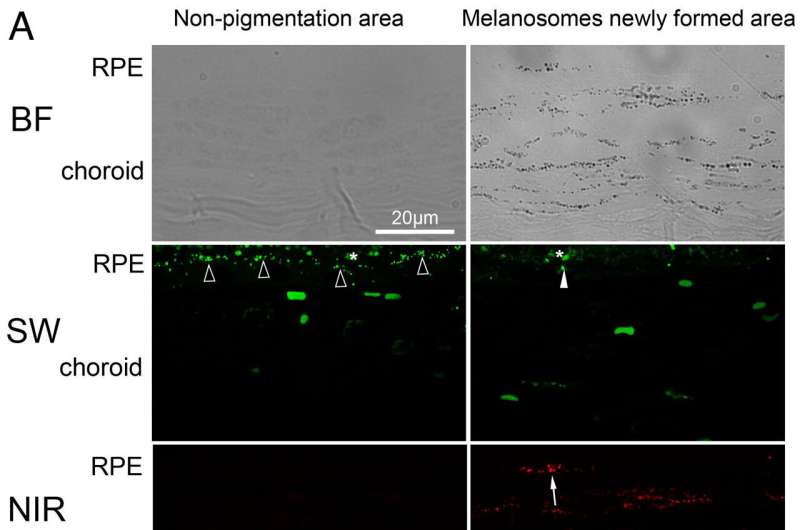This article has been reviewed according to Science X's editorial process and policies. Editors have highlighted the following attributes while ensuring the content's credibility:
fact-checked
peer-reviewed publication
trusted source
proofread
Quantum chemistry protects against age-related macular degeneration

The leading cause of vision loss in Western countries is age-related macular degeneration (AMD), a deterioration of central vision that begins when droplets of lipids and proteins called lipofuscin accumulate in the retina and damage cells. Effective treatments for AMD are not available, and it remains unclear how healthy eyes prevent this accumulation.
Researchers at Yale and the University of Tübingen in Germany, however, have uncovered part of the eye's protective mechanism in which an unusual quantum chemistry reaction involving melanin removes the lipofuscin. The discovery, they say, could inform AMD treatment going forward.
"It's beginning to look like melanin is nature's solution to a variety of biology's challenges," said Douglas E. Brash, professor of therapeutic radiology and dermatology at Yale and co-author of the new study.
The results were published May 8 in the Proceedings of the National Academy of Sciences.
Photoreceptors are specialized cells in the eye that convert light into signals that are then sent to the brain. The outer portion of these cells includes stacks of membranes called discs that are filled with rhodopsin, the molecule that captures light and converts it to an electrical signal. Once exposed to light, discs at the top of the stack undergo a recycling process in which useful material is collected to be reused. Meanwhile, new discs are formed at the base of the stack. This process repeats continuously throughout a person's life.
Some material that can't be broken down for disc turnover becomes lipofuscin. As lipofuscin accumulates, it damages cells in the retina and leads to AMD.
Previous research on albino mice has shown that lipofuscin accumulation and retinal damage occur earlier than others. So in the new study, researchers first used high-magnification electron microscopy to observe undigested discs in retinal cells of albino and pigmented mice genetically altered to model AMD.
"The remnants of undigestible discs were ten-fold more frequent in albino mice than in pigmented mice," said Ulrich Schraermeyer, a professor in the Center for Ophthalmology at the University of Tübingen and senior author of the study.
Melanin is a pigment found in hair, skin, and eyes; it varies between individuals and becomes less effective with age. It's also lacking in albino mice, causing their coloring. Suspecting the pigment may play a role in preventing the accumulation of lipofuscin, the research team induced melanin synthesis in albino mice. Doing so decreased the amount of lipofuscin in the mice, the researchers found.
Brash is interested in how ultraviolet light leads to skin cancer. In previous research, his lab discovered that chemical excitation of electrons, or "chemiexcitation," occurring within melanin can cause a reaction that leads to DNA damage.
"These quantum chemistry reactions excite a melanin electron to a high energy state and flip its spin, allowing unusual chemistry afterward," said Brash.
To test whether chemiexcitation might mediate lipofuscin removal, he identified compounds that can directly excite electrons without having to work through melanin and one compound that can block the chemiexcited melanin from initiating other reactions.
"We know that melanin becomes less effective as we get older," Brash said. "So once the Schraermeyer lab had determined that melanin was required for photoreceptor disc turnover and essential for preventing lipofuscin buildup, we wanted to see if a chemiexcited drug might be a way to circumvent melanin while inducing its effects."
The researchers tested the compounds on retinal tissue from albino mice.
"In two days, the lipofuscin diminished substantially," said Yanan Lyu, lead author of the study and a researcher at Shanghai General Hospital in China. "And that improvement was blocked by the excited-state quencher."
The subsequent chemistry by which the excited electrons reverse lipofuscin remains to be determined. But Schraermeyer is optimistic about translating this discovery to the clinic.
"For 30 years I was convinced that melanosomes—the organelles in cells that create melanin—degrade the lipofuscin but couldn't identify a mechanism," he said. "Chemiexcitation is the missing link, and it should let us bypass the problem that AMD begins when the eye's melanin declines with age. A drug that is chemiexcited directly may be a breakthrough for our patients."
More information: Yanan Lyu et al, Chemiexcitation and melanin in photoreceptor disc turnover and prevention of macular degeneration, Proceedings of the National Academy of Sciences (2023). DOI: 10.1073/pnas.2216935120





















